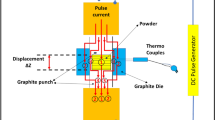Abstract
Thermal study and structural characterization of biological hydroxyapatite (HA) samples were done as well as their comparison with commercial and synthetic samples in this study. The X-ray micro analyser shows that all three samples of human teeth (HT1–HT3) contain two types of HA structures with different crystallite sizes, unlike sample of bovine thigh-bone (BTB). The bone sample was composed only of one HA phase with varied porosity. The molar Ca/P ratio in biological samples was lower compared to theoretical ratio for pure HA; moreover, in the case of teeth, Ca/P ratio varyies between the centre and the periphery of the cross-sectional samples. Thermogravimetry of the biological samples showed mass decreases—three regions for the bone and four regions for the teeth. In comparison, commercial HA has only two-step weight loss and synthetic HA three-step weight loss. After the calcination up to 1280 °C all the samples of teeth transformed into whitlockite, β-(Ca,Mg)3(PO4)2 (98 wt%) and 2 wt% HA. Besides, HT3 contained further trace amount of hilgenstockite (HIL, Ca4P2O9). The sample BTB partly transited from natural HA into HIL (6 wt%) and lime, CaO (14 wt%). X-ray powder diffraction (XRD) proved occurrence of HIL (9 wt%) beside stability part HA (91 wt%) in the commercial HA after thermal treatment but the synthetic HA composed from Ca3(PO4)2 (74 wt%) and HA (26 wt%).




Similar content being viewed by others
References
Palmer LC, Newcomb CJ, et al. Biomimetic systems for hydroxyapatite mineralization inspired by bone and enamel. Chem Rev. 2008;108:4754–83.
Dorozhkin SV. Calcium orthophosphates in nature, biology and medicine. Materials. 2009;2:399–498.
LeGeros RZ. Formation and transformation of calcium phosphates: relevance to vascular calcification. Z Kardiol. 2001;90:116–24.
Ito A, Onuma K. Crystal growth technology. London: Wiliam Andrew Publishing; 2003.
Chen ZF, Darvell BW, Leung VWH. Hydroxyapatite solubility in simple inorganic solutions. Arch Oral Biol. 2004;49:359–67.
Yujiro W, Toshiyuki I, Yasushi S. Type-A zeolites with hydroxyapatite surface layers formed by an ion exchange reaction. J Eur Ceram Soc. 2006;26:469–74.
Reddy MP, Venugopal A. Hydroxyapatite photocatalytic degradation of calmagite (an azo dye) in aqueous suspension. Appl Catal B. 2007;69:164–70.
Baillez S, Nzihou A, Bernache-Assolant D. Removal of aqueous lead ions by hydroxyapatites: equilibria and kinetic processes. J Hazard Mater. 2007;139:443–6.
Reddy MP, Venugopal A, Subrahmanyam M. Hydroxyapatite-supported Ag-TiO2 as Escherichia coli disinfection photocatalyst. Water Res. 2007;41:379–86.
Omelon SJ, Grynpas MD. Relationships between polyphosphate chemistry, biochemistry and apatite biomineralization. Chem Rev. 2008;108:4694–715.
Rey C, et al. Chemical diversity of apatites. Adv Sci Technol. 2006;49:27–36.
Daculsi G, Bouler JM, LeGeros RZ. Adaptive crystal formation in normal and pathological calcifications in synthetic calcium phosphate and related biomaterials. Int Rev Cytol. 1997;172:129–91.
LeGeros RZ. Calcium phosphates in oral biology and medicine. Basel: Karger; 1991.
Prakash KH, et al. Apparent solubility of hydroxyapatite in aqueous medium and its influence on the morphology of nanocrystallites with precipitation temperature. Langmuir. 2006;22:11002–8.
Sanosh KP, et al. Preparation and characterization of nano-hydroxyapatite powder using sol–gel technique. Bull Mater Sci. 2009;32:465–70.
Yoon SY, et al. Synthesis of hydroxyapatite whiskers by hydrolysis of α-tricalcium phosphate using microwave heating. Mater Chem Phys. 2005;91:48–53.
Earl JS, et al. Hydrothermal synthesis of hydroxyapatite. J Phys Conf Ser. 2006;26:268–71.
Kaloustian J, et al. The use of thermal analysis in determination of some urinary calculi of calcium oxalate. J Therm Anal Calorim. 2002;70:959–73.
Madhurambal G, Subha R, Mojumdar SC. Crystallization and thermal characterization of calcium hydrogen phosphate dihydrate crystals. J Therm Anal Calorim. 2009;96:73–6.
Paulik F, et al. Investigation of the composition and crystal structure of bone salt by derivatography and infrared spectrophotometry. Hoppe Seyler’s Z Physiol Chem. 1969;350:418–26.
Mezahi FZ, et al. Dissolution kinetic and structural behaviour of natural hydroxyapatite vs. thermal treatment. J Therm Anal Calorim. 2009;95:21–9.
Mitsionis AI, Vaimakis TC. A calorimetric study of the temperature effect on calcium phosphate precipitation. J Therm Anal Calorim. 2010;99:785–9.
Holager J. Thermogravimetric examination of enamel and dentin. J Dent Res. 1970;49:546–8.
JCPDS PDF-2 database, release 54. Newton Sq.: International Centre for Diffraction Data; 2004.
Diamanti I, et al. Effect of fluoride and of calcium sodium phosphosilicate toothpastes on pre-softened dentin demineralization and remineralization in vitro. J Dent. 2010;38:671–7.
Hattab FN. The state of fluorides in toothpastes. J Dent. 1989;17:47–54.
LeGeros RY, Bonel G, Legros R. Types of H2O in human enamel and in precipitated apatites. Calcif Tiss Res. 1987;26:111–8.
Wang L, Nancollas GH. Calcium orthophosphates: crystallization and dissolution. Chem Rew. 2008;108:4628–69.
McConnell D. Apatite. Vienna: Springer; 1973.
Posner AS. Crystal chemistry of bone mineral. Physiol Rev. 1969;49:760–92.
Shi D. Biomaterials and tissue engineering. Berlin: Springer; 2004.
Aras NK, Yiimaz G, Alkan S, Korkusuz F. Trace elements in human bone determined by neutron activation analysis. J Radioanal Nucl Chem. 1999;239:79–86.
Acknowledgements
This study was supported by the Czech Ministry of Education, Youth and Sports under the project MSM 0021627501, and IGA University of Pardubice (SGFChT04). Special thanks to Milan Vlček from Joint Laboratory of Solid State Chemistry, University of Pardubice.
Author information
Authors and Affiliations
Corresponding authors
Rights and permissions
About this article
Cite this article
Kohutová, A., Honcová, P., Svoboda, L. et al. Structural characterization and thermal behaviour of biological hydroxyapatite. J Therm Anal Calorim 108, 163–170 (2012). https://doi.org/10.1007/s10973-011-1942-6
Received:
Accepted:
Published:
Issue Date:
DOI: https://doi.org/10.1007/s10973-011-1942-6




